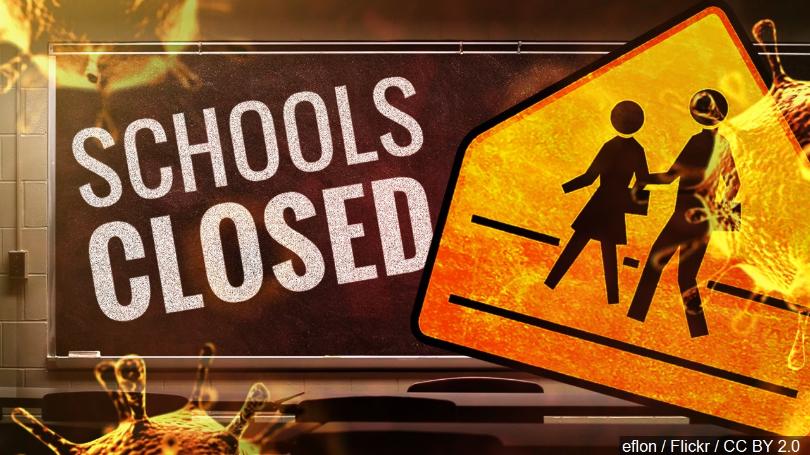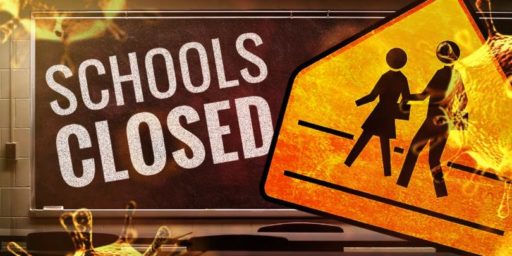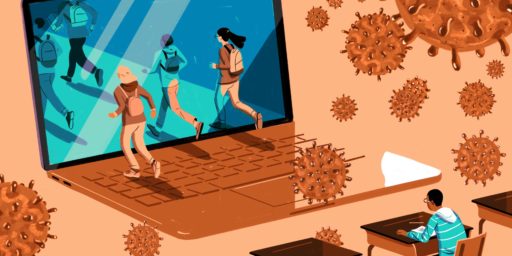Schools Remain Key to Reopening
Parents can't homeschool their kids and hold down jobs indefinitely.

Back in April, I noted that returning anything like a normal economy would require something like a full re-opening of the public schools in the fall. As we get closer, it’s looking dicey, indeed, in these parts.
Earlier this month, Governor Ralph Northam said K-12 schools could re-open as early as the summer.
Virginia Gov. Ralph Northam on Tuesday said that the state will allow schools to slowly resume in-person classes this summer and in the fall.
But school districts also will have discretion on how to implement Northam’s plans and may decide their schools will have additional restrictions, depending on local public health conditions. So, for example, schools in Northern Virginia worried about continued Covid-19 infections could decide to hold physical classes but also continue some remote learning.
Northam’s announcement means that by Friday [June 12], all public school districts and private schools in the Commonwealth can begin submitting to the state Department of Education their required plans for mitigating the spread and public health risk of Covid-19.
That must happen before they launch in-person instruction for certain student groups as part of Virginia’s phased reopening. But districts can expect they will be able to move forward once they send in their plans.
One suspects that more rural school districts, where the spread of the pandemic has been much slower, will be more aggressive. But Richmond and the Northern Virginia suburbs and exurbs of DC are taking a very slow approach.
My own school district—the largest in the state and tenth largest in the country—has given us a lousy choice.
Parents with students in Fairfax County Public Schools have some big decisions to make before fall 2020: Choosing whether to return to in-person classes or to keep their children in virtual education.
The virtual learning option would have students log on for full-time schooling. Interactive instruction will be offered four days a week.
Parents could also choose the in-person option, which would mean students spend at least two full days at school and do an independent study on other days. The school may be able to offer more than two days a week, depending on how many kids choose the virtual option.
Either way, many working parents will have to re-evaluate schedules and child care plans.
Fairfax County Public Schools Superintendent Scott Brabrand announced on Tuesday that parents will receive a letter next week asking them to state their preference.
More details on the plan will be released in coming weeks, Brabrand said. That plan will also feature more face-to-face instruction for English language learners and special education students.
Teachers will be given one day a week for extra planning and to give some students extra support. They will also be asked how they prefer to return, Braband said
My wife and I are both Federal employees with steady paychecks and extremely flexible options during this pandemic. I’m thankful that we can manage this but nonetheless angry that we’re not getting anything like the service that we’re paying for. We’re simultaneously being asked to pay full freight for less-than-half-assed instruction and to pick up the slack.
The schools have had months to figure this out; there should be better options by now. Granting that we’re dealing with adults and a much smaller student population, we managed the transition to online instruction damned near seamlessly and have figured out how to socially distance upon return (albeit delayed nearly a month) in the fall. As well as a hybrid option so that those students and instructors who need to operate remotely can do so.
Still, we’re much more fortunate than most. Hourly workers, in particular, tend not to be able to work remotely or to afford to outsource their childcare. People in neighboring Loudoun County are venting their frustration.
Dozens of parents gathered outside the Loudoun County School Administration Building Monday afternoon to protest an idea that would offer students two days of in-person instruction a week, mixed with three days of distance learning, when classes resume August 27.
The proposal will only go into effect if Virginia were in Phase 3 in August, and it still needs the approval of the Loudoun County School Board. The body is expected to discuss when to hold a final vote on the issue Tuesday night.
Loudoun County parent Erin Roselle Poe organized Monday’s protest. She said parents should make the final decision as to whether their students return to school buildings full-time.
“If they want to send their child to school, 100%, so be it,” she said. “If parents or family members feel it is a risk, they should have the choice to keep their family members home.”
Another parent, Jean-Paul Bergeaux, said he was worried about the implications staying at home could have on students’ social development in the future.
“Part of going to school is learning how to interact, how to do conflict resolution, how to have hard times, how to create friendships, how to do those things,” he said. “How do you do that if you’re not able to go to school?”
In a statement, Loudoun County Public Schools said it would like to have in-person learning for its students in August, but it added it first must keep them safe by following local and state health officials’ recommendations.
“Local health conditions and the phase of recovery we are in at the time will determine our plan, based on the state’s guidance that we comply with Centers for Disease Control and Prevention physical-distancing precautions and other measures to protect the health of students, staff members and families,” the statement reads.
Local teacher Andrea Weiskopf held a solo, counter-protest next to the school administration building Monday. She said she is still worried students and staff could get sick inside schools this fall.
“We need to listen to the science,” she said.
Obviously, both extremes are irrational. We have to make these decisions collectively rather than leaving it up to individual parents. At the same time, until there’s a vaccine, it’s never going to be truly safe and we can’t remain closed down indefinitely.
Few of our elementary and secondary schools are built to accommodate social distancing and it’s going to be difficult if not impossible to get small kids to wear masks all day.
It would seem that the middle course would be to have a rigorous testing regime in place, ensuring that only healthy kids are allowed to attend in-person instruction and require the sick kids to stay home or in some sort of separate facility.





That’s your apple to FCPS’ orange. They have to deal with 188,000 students aged 4 to 18, spread over nearly 200 schools, ranging from low-income to top 1%, one kid at home to several, some who don’t have internet access at home and some whose parents work for internet companies, some who are food insecure and some who aren’t, some who can walk to school and some who won’t get there without riding a bus (and we don’t even know how that will look yet either), some with stay-at-home moms/dads and some whose parents both work multiple jobs, some for whom English is not their first language…I could go on.
Please don’t compare your small, all-adult student population to that. Brabrand and his staff, the FCPS school board, the teachers and support employees, all have to deal with an unbelievable set of challenges here. As the saying goes, they’ll be building the plane while flying it.
There are no really good choices, only trying to find the least bad option, which will be different for different kids. It’s likely the only consistency will be how much it sucks for everyone.
@Mikey: They have been incredibly incompetent from the get-go compared to any of the neighboring districts. If the district is too large to manage—and many of us have been saying for years just in terms of snow closures—then it’s time to break it up.
Distance learning could work for responsible high school students, maybe even some junior high (grades 6-8) kids, but not below about grade 6. The younger the kids get, the dicier it gets. Some special-needs kids also don’t do well in distance learning environments.
Even if parents WFH, they need to work. I work from home. I wouldn’t have time to homeschool a kid.
A couple of points:
This pandemic demonstrates how dependent the economy is on child care services whether provided by the school systems or childcare centers. And the lower income you are the more dependent you are.
I know in Texas they are struggling with how to do this. My wife is an elementary school teacher and is involved in the planning also. It is tough. And we have a well run and well funded school district.
There is always a problem with the Texas Education Agency. Almost, every time someone steps out ahead of the pack, the TEA rolls in with their opinion and rules, which are driven more by politics and money (not necessarily wrong) than education.
The issues with education always revolves around one principle: the schools have to take into account all children; parents only are concerned with their own. Neither is wrong; however, this tension drives a lot of the issues and angst.
I think there are going to be teacher shortages. The contract cycle is not over yet. I think there are going to be a lot of older teacher who hang it up rather than go back. My wife is not but I’m not looking forward to her mingling with all those little disease vectors and then coming home.
I’ve seen several references to studies showing that closing schools is not effective in slowing the virus. I find this highly counterintuitive, but if experts concur that this is what the data shows, so be it. Opening schools would be a big step toward normalcy and ease the disproportionate burden on people who have to physically go to work or lose their jobs. I wonder if there’s similar data on day care.
The quoted article says schools are required to submit plans. I hope VA isn’t going all red state and will review and disapprove substandard plans. I also hope the state is taking steps to assure PPE, cleaning supplies, training, and whatever else is needed are available. And honestly, aren’t school environments uniform enough across the state that it makes sense to have a state level plan? One grade school classroom looks and operates pretty much like any other. Granted, parents out around Bristol may be less receptive to restrictions, but is that a valid reason to expose them and their kids to more risk?
@gVOR08: Here’s a brief summary supporting that view, from a couple of weeks ago.
Name them.
The reality is that there aren’t any good options.
@MarkedMan: Read the article the first time around. I still am inclined to think that the reason that school closures were incidental in Covid-19 spread is because we closed them. If we want to run not closing them because their being closed does not appear to have made a difference in spread, I’m okay with it as I am old, have no children or grandchildren to infect me with SARS CoV2, and can control my appearances at my district’s schools in a county where after a YUUUUUUUGE spike in cases (we had 11 more cases overnight), we still don’t have o.2% infection rate.
If I lived in Seattle instead, meh… maybe I wouldn’t want to roll the dice. Maybe I’d have even told my school districts “no” on substituting this year. Laissez les bons temps roullez!
ETA:@SKI: “The reality is that there aren’t any good options.”
THIS!!! Times about 20 or 30.
@Scott:
This this this, a thousand times this.
In first-world countries, child care is considered infrastructure — like having roads, and water treatment plants, and street lights. It’s one of those things that everyone pays for because it more than repays its costs, in benefits that do not accrue only to the wealthy.
Which explains why we don’t have universal preschool here, whereas they do in countries like North Korea. 🙁
ETA: Although to be fair, many Americans are ambivalent about water treatment plants, too. 🙁
@DrDaveT: We stopped electing Republicans much at the national level in 1932 because of the Great Depression. We then got out of the Depression, won WWII, and experienced 30 years of prosperity. Then around 1980 we started electing Republicans in significant numbers again. It’s something of a testament to the strength of our society that it took them forty years of hard work to turn us into a third world country.
Speaking from experience the ‘less than half assed instruction” kids are getting costs more time and effort for prep, as much contact time, and involves more meetings to coordinate and plan, and all has to be done with our own kids at home.
In China they have an elaborate system to check the kids and disinfect them when they arrive at school.
@Monala:
I think we need to pilot the same system here.
My concern isn’t so much parents getting back to work as it is kids getting back to school. As I mentioned above, distance learning only works in higher grades, and then only with more responsible students who don’t also have special needs that require on-prem instruction.
Having all these kids in education limbo is a disaster. They need to be in school, or they’re going to wind up falling back several grade levels, and that is going to bite all of us in the ass later on, when they’re totally unprepared to enter a highly technical workforce that requires more skills than ever, even at the entry level.
Of course, even an elaborate sanitation system won’t work if COVID-19 continues to rage out of control, which it clearly will. <—– I sincerely hope I'm wrong about that. I want to see the GOP crash and burn, but not at the expense of hundreds of thousands, perhaps millions of lives.
I call total and complete bullshit on the study that said closing the schools didn’t seem to affect transmission. This shit would’ve blown up big time if they had continued daily school and high school/college sporting events. The kids might not have died, but all the grannies and grandpa’s that attended all their games would’ve.